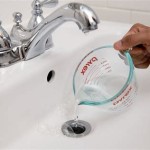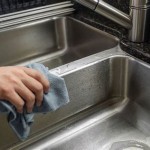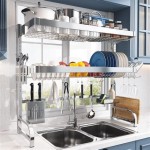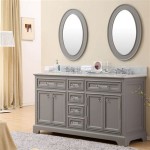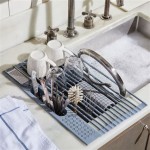Bathroom Sink Smells When Running Water: Causes and Solutions
A foul odor emanating from a bathroom sink when running water is a disconcerting issue that many homeowners encounter. It can range from a mildly unpleasant musty scent to a strong, offensive sewer-like smell, significantly impacting the bathroom environment and overall comfort. Identifying the root cause is crucial for implementing effective solutions and preventing the problem from recurring. Several factors can contribute to this issue, many of which are related to plumbing systems and the accumulation of organic matter.
The presence of a bad smell when running water in a bathroom sink is not only an annoyance but also a potential indicator of underlying plumbing problems. Ignoring the odor could lead to more serious issues, such as clogged drains, bacterial growth, and even potential health hazards. Therefore, a thorough understanding of the common causes and appropriate troubleshooting steps is essential for maintaining a clean and healthy bathroom environment.
This article provides a detailed exploration of the potential causes behind a bathroom sink smelling when running water. It also offers practical guidance on how to diagnose the problem, implement effective solutions, and prevent future occurrences. By understanding the intricacies of plumbing systems and recognizing the signs of common issues, homeowners can proactively address unpleasant odors and maintain a hygienic bathroom.
Biofilm Buildup in the Drain and Overflow
One of the most frequent culprits behind a smelly bathroom sink is the accumulation of biofilm within the drain and overflow. Biofilm is a complex community of microorganisms, including bacteria, fungi, and algae, that adhere to surfaces in moist environments. In the context of a bathroom sink, this biofilm develops due to the constant exposure to water, soap residue, hair, skin cells, and other organic matter that washes down the drain.
The drainpipe and overflow channel provide ideal conditions for biofilm growth due to their dark, damp environment and the constant supply of nutrients. As the biofilm matures, it decomposes the organic matter it contains, releasing foul-smelling gases such as hydrogen sulfide (which smells like rotten eggs), ammonia, and methane. These gases are then emitted through the drain when water is run, carrying the unpleasant odor into the bathroom.
The composition of the biofilm can vary depending on the specific types of bacteria and fungi present, as well as the substances that are regularly flushed down the drain. For example, sinks used frequently for shaving may accumulate hair and shaving cream residue, which can contribute to a particularly strong and unpleasant odor. Similarly, sinks used for washing makeup brushes may accumulate makeup residue that also decomposes and contributes to the smell.
Addressing biofilm buildup requires a multi-pronged approach. Simple flushing with hot water is often insufficient to remove the entire biofilm, as it is highly resistant to detachment. More aggressive methods, such as using enzymatic drain cleaners that break down the organic matter or physically scrubbing the drain with a brush, are typically necessary for a thorough cleaning. Regularly cleaning the drain and overflow can prevent the accumulation of biofilm and reduce the likelihood of unpleasant odors.
In some cases, the biofilm may be particularly thick and resistant to conventional cleaning methods. In such situations, a professional plumber may be required to perform a more thorough cleaning of the drainpipe using specialized equipment, such as a drain auger or hydro jetting.
Dry or Improperly Installed P-Trap
The P-trap is a U-shaped section of pipe located beneath the sink that is specifically designed to trap water. This trapped water acts as a barrier, preventing sewer gases from entering the bathroom through the drain. When the P-trap is functioning correctly, it effectively seals off the plumbing system from the potentially harmful and unpleasant odors of the sewer.
However, if the P-trap is dry or improperly installed, it can no longer perform its intended function. A dry P-trap occurs when the water in the trap evaporates, typically due to infrequent use of the sink. This is particularly common in guest bathrooms or sinks that are only used sporadically. Without the water barrier, sewer gases can freely flow up through the drain and into the bathroom, causing a noticeable and often offensive odor.
An improperly installed P-trap may also fail to create an adequate water seal. This can occur if the trap is not properly aligned, if the connection points are loose, or if there is a crack or other damage to the pipe. In these cases, even if there is water in the trap, it may not be sufficient to prevent sewer gases from escaping.
Diagnosing a dry P-trap is relatively straightforward. If the sink has not been used for a period of time, and a bad odor is present when water is run, it is highly likely that the P-trap has dried out. The solution is equally simple: run water down the drain for a few minutes to refill the P-trap. This should restore the water barrier and eliminate the odor.
Addressing an improperly installed or damaged P-trap requires a more involved approach. If the P-trap is loose or misaligned, it may be possible to tighten the connections or adjust the position of the pipe. However, if the P-trap is cracked or otherwise damaged, it will need to be replaced. This is a relatively common plumbing repair that can be performed by a qualified plumber.
Preventing a dry P-trap involves ensuring that all sinks are used regularly. If a sink is not used frequently, periodically running water down the drain for a few minutes can help to maintain the water seal and prevent sewer gases from entering the bathroom.
Ventilation Problems in the Plumbing System
The plumbing system relies on a network of vents to properly regulate air pressure and allow wastewater to flow freely. These vents typically extend from the drainpipes to the roof of the house, allowing air to enter the system and prevent a vacuum from forming as water drains. Without adequate ventilation, the pressure differences can cause water to be siphoned out of the P-traps, leading to sewer gas leaks and unpleasant odors.
A clogged or blocked vent is a common cause of ventilation problems in the plumbing system. This can occur due to debris such as leaves, bird nests, or other materials accumulating in the vent pipe on the roof. When the vent is blocked, air cannot enter the system, and the resulting pressure imbalance can draw water out of the P-traps, allowing sewer gases to escape through the drain.
Another potential cause of ventilation problems is a misplaced or improperly installed vent. If the vent is located too close to a window or other opening, it may allow sewer gases to enter the building directly, rather than being dispersed into the atmosphere. Similarly, if the vent is not properly connected to the drainpipes, it may not provide adequate ventilation for the system.
Diagnosing ventilation problems can be challenging, as the symptoms can be similar to those caused by other issues, such as a dry P-trap or biofilm buildup. However, if multiple sinks or drains in the house are experiencing odor problems, it is more likely that the cause is a ventilation issue rather than a localized problem in a single drain.
Addressing ventilation problems typically requires the assistance of a qualified plumber. The plumber can inspect the vent pipes for clogs or obstructions, and can also assess the placement and installation of the vents to ensure that they are functioning correctly. Clearing a clogged vent often involves using a drain snake or other specialized tools to remove the debris. In some cases, it may be necessary to relocate or replace the vent to ensure adequate ventilation for the plumbing system.
Preventing ventilation problems involves regularly inspecting and maintaining the vent pipes on the roof. This may involve removing any debris that has accumulated in the vents and ensuring that the vent caps are in good condition. It is also important to avoid pouring grease or other materials down the drain that could contribute to clogs in the plumbing system.
Clogged or Partially Blocked Drain
A clogged or partially blocked drain can significantly contribute to unpleasant odors emanating from the bathroom sink when water is running. The obstruction, typically composed of hair, soap scum, grease, and other debris, prevents water from flowing freely through the drainpipe. This stagnant water becomes a breeding ground for bacteria and other microorganisms that thrive on the decaying organic matter trapped within the clog.
As these microorganisms break down the debris, they release foul-smelling gases, such as hydrogen sulfide, methane, and ammonia. These gases are then forced up through the drain when running water disturbs the stagnant water and debris in the partially blocked pipe. The restricted flow of water also leads to a buildup of these gases within the pipe, intensifying the odor.
The severity of the odor often correlates with the extent of the blockage. A minor clog might produce a faint, musty smell, while a more severe blockage can result in a strong, repulsive odor resembling rotten eggs or sewage. Furthermore, the standing water trapped by the clog provides an ideal environment for the growth of mold and mildew, which can further contribute to unpleasant smells.
Identifying a clogged or partially blocked drain is usually straightforward. Slow drainage is a common symptom, where water takes longer than usual to empty from the sink. Gurgling sounds coming from the drainpipe can also indicate a blockage as air bubbles are forced through the obstructed passage. In addition, the presence of visible debris around the drain opening is a clear sign of a potential clog.
Addressing a clogged or partially blocked drain can be achieved through several methods, depending on the severity of the blockage. Over-the-counter drain cleaners are often effective for dissolving minor clogs. These typically contain chemical agents that break down organic matter. However, caution is advised when using chemical drain cleaners, as they can be corrosive and potentially damage pipes if used improperly. Always follow the manufacturer's instructions carefully and wear appropriate protective gear.
Another common method for clearing clogs is using a plunger. The plunging action creates pressure that can dislodge the obstruction, allowing it to flow freely through the drainpipe. For more stubborn clogs, a drain snake or auger can be used to physically break up and remove the blockage. These tools consist of a flexible metal cable that is inserted into the drainpipe to break up or retrieve the clog.
Preventing clogged drains requires regular maintenance and mindful practices. Avoid pouring grease, oil, or food scraps down the drain, as these substances can solidify and accumulate, forming a blockage. Install a drain strainer or screen to catch hair and other debris before they enter the drainpipe. Periodically flush the drain with hot water to help dissolve grease and prevent buildup. By following these simple preventive measures, homeowners can significantly reduce the risk of clogged drains and the associated unpleasant odors in their bathroom sinks.

How To Clean A Stinky Sink Drain Home Repair Tutor

How To Get Rid Of Sink Smell Benjamin Franklin Plumbing

Moldy Smelling Water From Bathroom Faucet Hometalk

How To Get Rid Of The Sewer Smell From A Bathroom Terry S Plumbing

What Causes Bathroom Drains To Smell

How Can I Help A Stinky Bathroom Sink Drain Cleaning More Youtube

How To Clean A Stinky Sink Drain Home Repair Tutor
My Bathroom Smells Bad But Only When Its Hot Outside It Also Will Slightly Go Away I Run The Sink And Toilet Bathtub Any Thoughts On What Is

Why Your Bathroom Sink Drain Smells

How To Clean Stinky Drains Liquid Plumr
